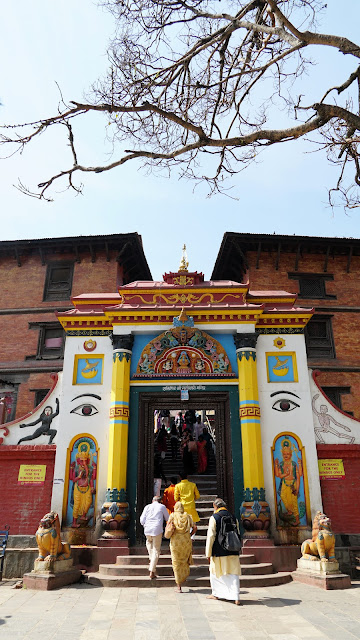Nepal: Hanuman-Dhoka Durbar Square, Boudhanath Stupa and Pashupatinath Temple
By Cubie - November 30, 2024
 |
| Jagannath Temple |
Hanuman-Dhoka Durbar Square / Kathmandu Durbar Square
Entrance fee: NPR 1,000
Ticket issued is only valid on the issued date but ticket can be extended for free for the duration of your visa with a photo. I didn't have a photograph but I was issued an extension for a day (visitor pass). The two tourists in front of me were told to get their photograph taken and return to get an issuance of a visitor pass. Possibly they needed more days.
Hanuman-Dhoka Durbar Square is located at the heart of ancient city Kathmandu. Within this square, one can find Hindu and Buddhist temples and shrines, and palaces. The name of the square came from the status of Hanuman established by King Pratap Malla at the entrance of the Royal Palace in 1672 A.D. This building had scaffolding all over it during my visit. The square is made up of 2 sub-areas, with inner complex mostly comprises of old palace areas and its courtyards while the outer complex houses numerous temples.
 |
| Lohan Chowk, one of the courtyards |
 |
| Nasal Chowk |
 |
| Kal Bhairav |
This stone image of Bhairav represents deity Shiv in his destructive manifestation. It is undated but was set in its present location by King Pratap Malla after it was found in a field to the north of the city. This is the most famous Bhairav and used by the government as a place for people to sear the truth.
I wonder if this is the other side of the Taleju Temple, built in 1564 A.D by King Mahendra Malla. It was previously considered very inauspicious to build a house higher than this temple. This temple is only opened once a year during Dashain for the public. Dashain, or the great harvest festival of Nepal symbolises the victory of good over evil, celebrating the goddess Durga’s defeat of the demon Mahishasura.
At certain set times of the day, the kumari appears in the company of her guardian priestess to see and be seen at the Kumari-Ghar / Kumari Bahal. The Kumari-Ghar is a 3 storey quadrangle building where kumari lives. 'Kumari' or the living goddess who is considered to be an incarnation of the goddess Taleju.
Boudhanath Stupa / Jharung Khashor
Entrance fee: NPR 400
Getting there from Thamel
Bus fare: NPR 30
Take little blue vans from Ratna Park and asked for 'Boudhanath Stupa'. I read that it is the side near Rani Pokhari (beside Kanthi Pathi Avenue) but I didn't see them, so I did the usual of asking the bus drivers.
The Boudhanath Stupda was built in the 5th century, and it is one of the most ancient, largest and magnificent stupas in the world. According to the legend, a woman named Jadzima had an aspiration to make an offering to the Buddha by building a great Stupa. Her 4 sons completed the construction of Stupa after the passing of their mother even during an ongoing drought in the country. The devotees laid out cloth at night to collect morning dew to mix in to mortar for construction. It was said that when the Stupa was completed, the sun did not set for 5 days.
You will see devotees or visitors walking clockwise around stupa, i.e. the stupa to your right.
The same as the prayer wheels, to be spun clockwise.
You can enter the stupa and climb up to the white dome.
Pashupatinath Temple
If you want pictures of Sadhus, I saw a few at the Kathmandu Durbar Square, I'm not sure if they were real Sadhus but I think they charged money if you photographed them. They gestured me for me to go over but I didn't. I was feeling really tired from avoiding children following me and asking for money at that time.
Entrance fee: NPR 1,000 (sourced from internet)
I was too cheapskate to pay the entrance fee to just walk around the grounds as non-Hindus is not allowed to enter the temple complex.
Pashupatinath Temple is by the Baghmati River, on the eastern outskirts of the city of Kathmandu. It is devoted to the Hindu god Shiva in his form as Pashupati, protector of animals. The main temple complex is open only to the Hindus; non-Hindus can only observe from the terraces just across the Bagmati River to the east.
I walked from Boudhanath Stupa to the entrance of the temple, pondered if I want to pay for the entrance fee to walk around the compound but decided against it. So I left and walk around it to the other side.
The other famous stupa that I didn't visit is the Swayambhunath Stupa or the 'Monkey Temple' because I am scared of monkeys. There were monkeys on my walk from Boudhanath Stupa to Pashupatinath Temple though.







1 comments
"Great info! You've showcased the beauty and history of Hanuman Dhoka Durbar Square so well."golden triangle tour 3 nights 4 days
ReplyDelete